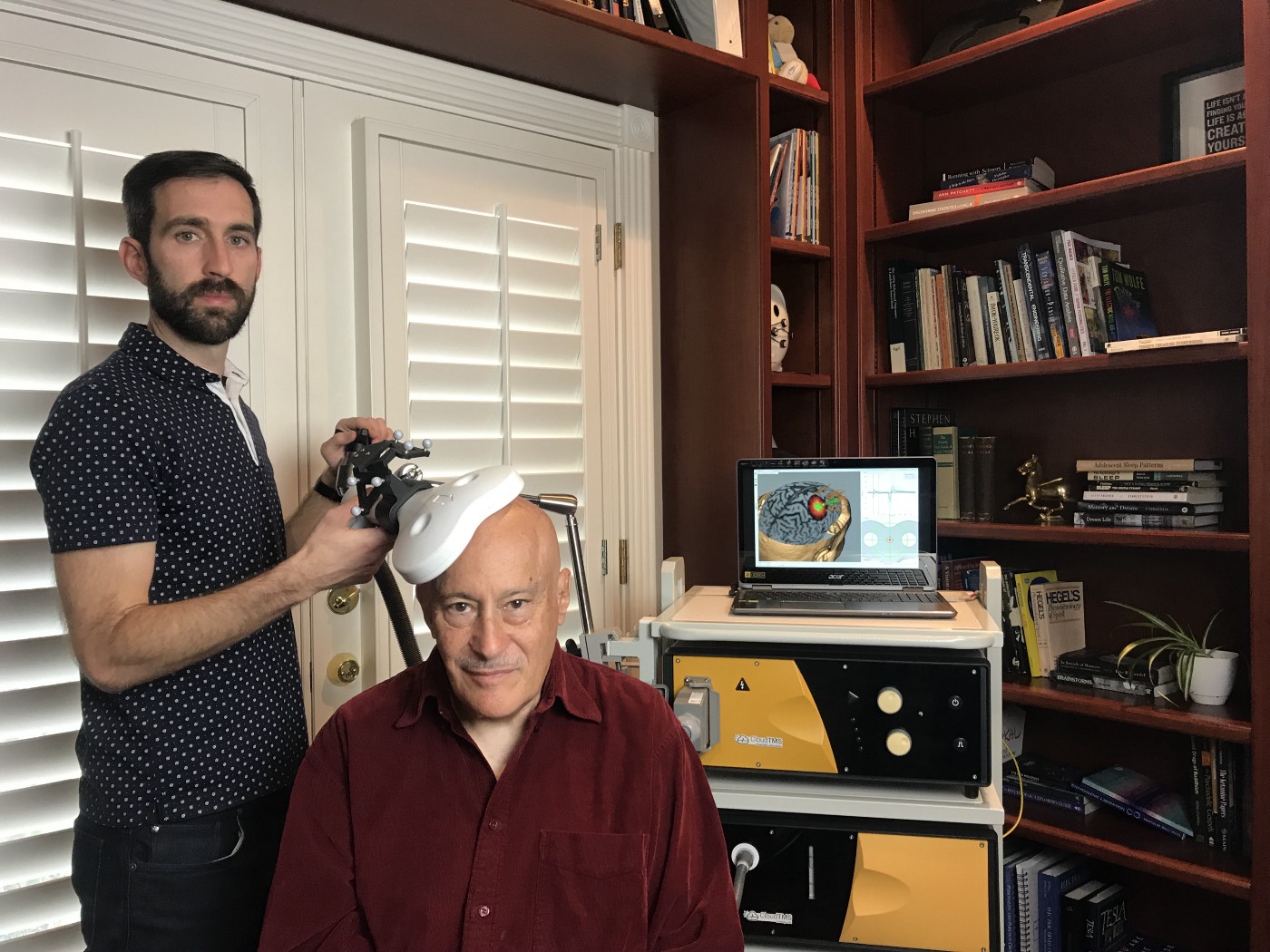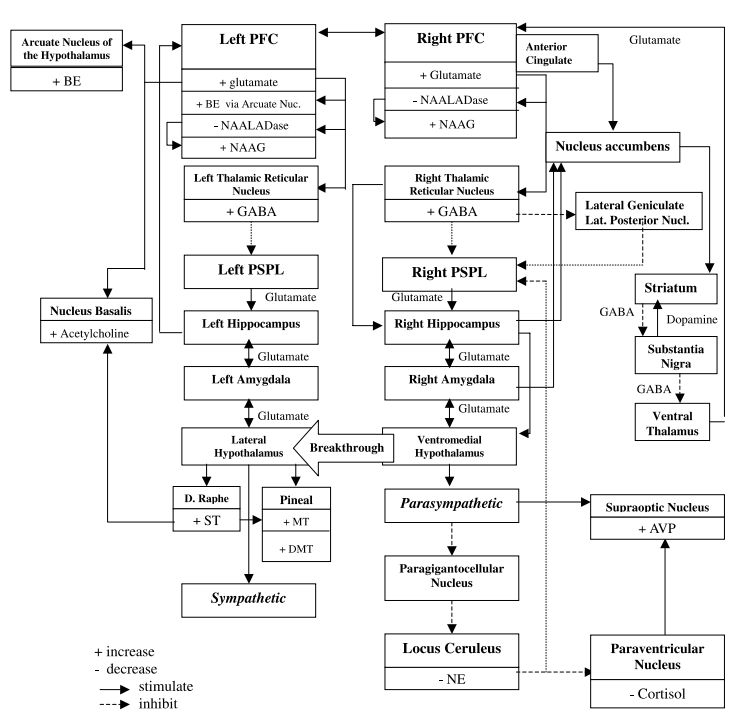I don’t know what the word ‘enlightenment’ means to you. Or the word ‘meditation’, or ‘spirituality’ or anything. But what ‘enlightenment’ in Buddhism has always refered to historically has been achieved by people time and time again, and can be achieved by you and I in this very life, too. I’m not here to convince anybody of anything, but at the very least let me tell you that it’s not about mystical powers; it’s a radically different mode of perception from the ordinary, and it takes a lot of work and meditation in order to clean the lens of perception from conditioning you didn’t even know was there, until all you’re left with is what’s always been there underlying it all.
Essentially, you can thank the monastic culture of (understandably) shying away from sharing attainments for the relative obscurity of the entire project and how tangibly progress along the path is demarcated, whereby full enlightenment (when we’re going off the four path model right out of the suttas) is just the final step on it.
There are discrete, well-catalogued steps along the way: ~12-16 of them leading up to the first stage of enlightenment out of 4, known as stream entry. See: The Progress of Insight by Mahasi Sayadaw or 30. The Progress of Insight - MCTB, and Four stages of awakening - Wikipedia. Roger Thisdell has one of the best (especially considering it’s brief) explanations I’ve ever seen of the 4 stages of enlightenment: Stage Theory of Enlightenment (it has “theory” in the title, but I dare say I’m dogmatic enough to say that it’s hardly “theoretical”.)
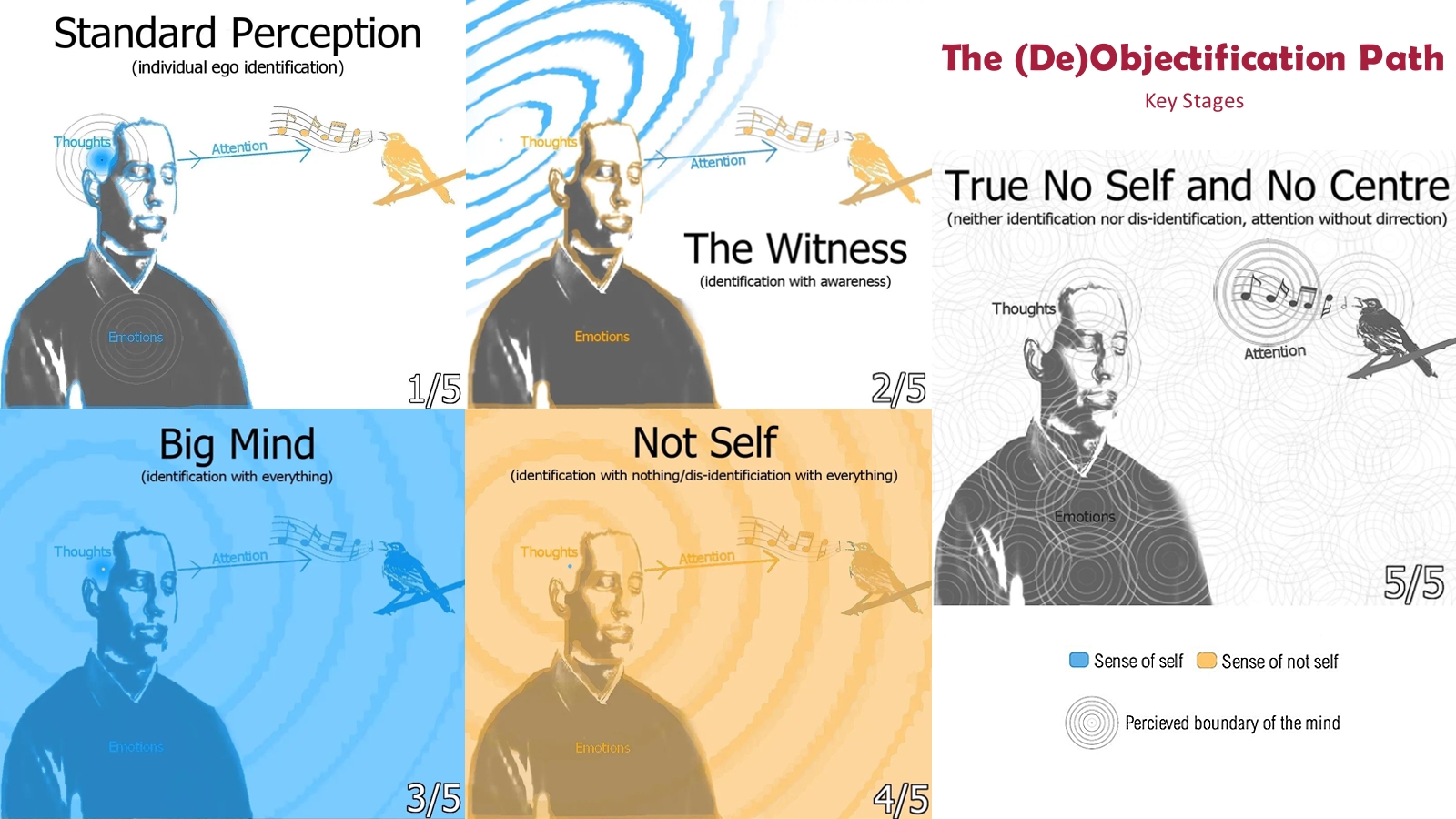
When you are ready, I highly recommend reading Daniel Ingram’s Mastering the Core Teachings of the Buddha. This is the closest thing to a ‘bible’ for awakening insofar as it’s a great starting place that could get the average person from start to finish, especially in that it also recommends other books, teachers, etc. I also highly recommend Frank Yang’s videos on Youtube to get a more visceral idea of how deep this really goes; how profoundly your perception changes. He’s documented his entire journey from the first sit to 4th path.
Again, I’m not very good at convincing people of things. I’m just writing here to share resources and research. As for the scientific section, my goal in the future is for us to understand the neurophysiological underpinnings of meditative progress and democratize it; in other words, develop neuroprosthetic, pharmacological, or otherwise technological interventions that facilitate progress without the tedious work of meditation. Not (just) for a wealthy elite, but also eventually for people who lack have the timenergy for meditation in the first place. I anticipate that this will, ideally, have profound effects on the global political organization of the human species and will exponentially promote cooperation that’s totally forward-thinking and increasingly pareto-efficient, and ultimately bring an end to all war and conflict. That’s mostly not a joke.
Or at the very least, use the neuroscience in order to understand the path and the process of meditation itself a little better. And as far as I’m aware, we’re still quite a ways off from determining any neural substrate for progress. For now we’ll just sit our asses down and meditate.
Cf. Zen and the art of speedrunning enlightenment
Meditation
I’m no meditation teacher, but if there’s any advice I could give to my younger self a few years ago, the main thing would be to stick to one technique—the technique you’re best at—which in my case is noting, and to stick with it without deviation, and maintain a minimum of ~90 minutes of sitting practice daily. The more the better. 2 hours is apparently a good sweet spot. Meditate at the same time of day, too. Intuitively speaking, this would promote hebbian learning to the highest possible extent (besides adding more time, such as in a retreat(-like) context) and it’ll gradually train your mind to unconsciously just know that now is a good time you can totally let go. Not being able to just let go has been my #1 problem, and letting go is practically the entire path in a nutshell.
But yeah, I think you should stick to the technique you’re best at, because what else are you going to have the motivation to do? You need to be haveng fun, actually. You need to be energetic, inquisitive, vigilant, etc. If you hate the technique you’re doing right from the get-go I think you’re probably screwed. There’s the sentiment that you should work on what you’re weak at, but frankly I don’t know how skillful that is. There’s also the notion that the duality expansion and contraction eventually collapses; some people may have a proclivity for contractive practices, some for expansion.
This is obviously not a comprehensive list, but some of the more robust techniques that really produce results would be include, in rough order from shamatha-focused to vipassana (take the exact order with a a grain of salt)
- Mantras: TM (David Lynch, lol), Vajrayana, etc.
- Visualizations
- Anapanasati (breath): The Mind Illuminated, Rob Burbea, Leigh Brasington, Sutra-inspired style “awareness”, Thai Forest, and many more.
- Kasina: with a candle (fire kasina), a bowl, a disk of construction paper, a body of water, etc.
- Daniel Ingram claims that fire kasina and mahasi noting seem to be similar in terms of how quickly one goes through the progress of insight. But don’t get it twisted, this develops some serious concentration, and easily—like easier than anapanasati (I have heard it expressed in multiple contexts (example) that it just seems better than anapana and we might be leaps and bounds ahead in the meditation world had kasina been the default ‘concentration’ or ‘meditation’ practice). And, importantly, it’s fun, and it can get seriously trippy (for better or worse—don’t underestimate that; see some of the podcasts below). It’s also great at increasing lucidity of dreams (dream yoga!)—clearly it’s is a cool practice to do at night.
- See: https://firekasina.org/, and Daniel Ingram’s interviews on the topic:
- Kasinas - Discussion - The Dharma Overground
- Fire Kasina Hints for Shinzen Meditators
- How to blast through dullness into clarity and How to Practice Kasina Meditation: A Guide for Beginners from duffstoic.
- The Yogi Toolbox: Candle Flame Kasina Practice
- Mettā: TWIM, Rob Burbea
- Roger Thisdell - How to Meditate: Metta (loving-kindness)
- Mettā is actually the opposite of craving , not ‘hatred’ (whose opposite is equanimity). From this, it should be a little more clear how it’s a perfectly valid object for attaining jhana.
- Practicing Love - Tasshin
- MIDL (Mindfulness in Daily Life) Insight Meditation
- Vipassanā Body Scanning: S.N. Goenka (U Ba Khin lineage)
- Fast noting: Daniel Ingram, Shinzen Young
- Detailed noting: Kenneth Folk
Rather outside of that continuum are:
-
Shikantaza (“just sitting”)/"Do nothing". Possibly not the best for complete beginners to meditation, but it is a complete path.
-
‘Nondual’ type practices like Dzogchen which are generally more ‘advanced’, becoming more intuitive after stream entry.
-
Dream Yoga; the practice of meditation inside lucid dreams (and obviously relevant in the general practice is inducing lucid dreams in the first place).
-
There all all kinds of different styles of the above techniques. Anapanasati is probably taught by tens of thousands of different people, though I’m bad at numbers. The Mind Illuminated is recommended, but worrying and over-efforting about the stages is something I had trobule with, though YMMV. Rob Burbea is great and so are his dharma talk recordings on the jhanas, etc. A lot of people have written about the Jhanas:
Also yeah, I find it kind of hilarious how the concept of jhana infiltrated the hyper-materialist memplex of LessWrong, EA, e/acc, etc. In its wake there are (increasingly secular) efforts like Jhourney that aim to popularize its existence and relative accessibility. Here’s hoping the dharma-free™ methodology of this memeplex doesn’t prove to be a stopgap game of telephone that draws people away from the path to awakening, but I don’t really see that as a possibility, because jhanas are profound, and that sure as hell primes somebody for the rest of the teachings that Buddhism provides. There are more things in heaven and earth, Horatio, than are dreamt of in your philosophy. My simple request to this strawman of mine is that one should keep in mind (you may see this coming) that the Buddha was not satisfied even after achieving all 8 jhanas, for jhana alone will not liberate you from suffering. But again: not a thing wrong with it really. Wild descriptions of peak experiences are probably what initially got me interested in meditation.
Neurofeedback, Neuromodulation, etc.
It’s clear that there’s a hierarchy of sorts with meditation → neurofeebdack → neuromodulation via tACS/tDCS, rTMS, ultrasound, etc. in order of difficulty and effort, and I wonder if this isn’t very important for facilitating certain neurogenic changes. What I mean is:
-
Meditation involves focusing one’s attention on a certain object via (what one would assume are primarily prefrontal) efferents (which is really in concert with myriad other regions) which also controls the activity of other regions. Meditation also involves the activation of self-monitoring regions making sure that you’re actually following the technique properly and conducively—that is to say, following the seven factors of awakening. Now you could say that the monitoring and the technique are one and the same (experientially or otherwise), but at the end of the day it also still seems to be a discrete process distributed in different networks across spacetime. I’d have to think about that though. But this is essentially the distinction made in The Mind Illuminated between attention and (peripheral) awareness.
-
Neurofeedback (and very involved guided meditations, perhaps) still involves following a technique, but the monitoring component is offloaded to the feedback mechanism whose very purpose is to be more concrete than the meditator ‘interpreting’ the noisy wetware of their brain. I think as a result, the scope of the technique and what you’re monitoring for has been limited quite significantly; there’s way less mistaking which qualia are positive signals. Either the brain regions responsible for monitoring are now focused on the feedback (as the brain with the protocol such as a certain level of prefrontal alpha wave activity, a noise goes from loud to quiet, or a light goes from dim to bright), or perhaps it’s a different regions entirely.
-
Neuromodulation then attenuates the conscious volition component, and not only that but essentially makes monitoring extraeneous. (Assuming here the montages are placing electrodes on regions of the prefrontal cortex)
But is it really the same as tried and true meditation as one goes down the hierarchy? This is what I ask here. The idea either is to train one’s natural ability to enter a given state, andor align one’s default state/qEEG with the protocol (much better for our purposes here, of course). If you take the helmet off and you’re the exact same as before, it’d be pretty gimmicky. Momentary stress relief or what have you is obviously not really the goal with (insight) meditation, or really any neurofeedback protocol worth its salt. So if you’re training the default activity, you’re trying to elicit a certain general cascade of plasticity: it’s hard to say it would be the exact same as meditation—is that important, or no?
Furthermore, another one of the biggest questions is if the brain changes seen in meditators are causative, such that instantly copy+pasting the analogous connection from awakened/experienced brain A → novice brain B (even if such a thing could be done rapidly or semi-reliably with a certain technological intervention) would place person B’s default state into a level of insight just like person A (or mostly there, or leaves them in the same state but places them on the fast lane with minimal ensuing effort, etc., since our brains are all different and certain steps may be close to impossible at least without extremely sophisticated brain-remodeling technology), or are these changes merely an arbitrary end result—an epiphenomenon—perhaps even from something that goes beyond the current scientific paradigm or even our own comprehension? Because on the one hand there’s the undeniable fact brain activity gives rise/plays a role to somebody’s current activity, wakefulness, etc. yet the experiential reality tells us that it’s actually consciousness that’s giving rise to all of reality including the brain.
I’m thinking out loud a lot here. But I think a lot of important questions come out of this.
- https://tagsync.com/ is one of the coolest things ever. He devised a neurofeedback program for facilitating the cross-frequency coupling between theta, alpha, and gamma. This ménage à trois might represent a key component of the brain’s higher functions: “TAG Sync is a phenomenon seen in the brain waves (EEG) during learning, insight, problem solving, & the near death experience”.
Dharma Links/Resources
You will (probably) never in your entire life attain profound insight just from reading something. Meditation is all that matters (broadly speaking). That being said, you must learn how to practice effectively and in accordance with your skills, which is easier said than done for most people.
-
Kenneth Folk: his E-book Contemplative Fitness, which is absolutely fantastic (this book is a great all-in-one guide for introducing somebody to pragmatic dharma as a whole—because also you could read it in a day if you really wanted) as well as his Youtube videos, which are also informative.
-
Daniel Ingram and his book Mastering the Core Teachings of the Buddha, free to read online. Masterpiece. Tl;dr of the entire book is to observe The Three Characteristics faster and faster and at a more and more minute scale. See here:
- Not trying to practice, lost in our stuff, spacing out, mindfulness weak.
- Mindfulness weak, lost in our stuff, but at least attempting some technique or just basic attention to what is happening at times, even if we can’t actually do it for long. People spend whole retreats at this level, unfortunately.
- Better able to practice, albeit with frequent interruptions, and to follow basic instructions such as noting, body scanning, or whatever you are trying to do.
- Able to do a specific vipassana technique or set of techniques that allows you to stay with aspects of your sensate reality as it presents with few interruptions.
- Able to apply those techniques or practices uninterruptedly.
- Able to perceive directly the three characteristics of objects in the center of attention consistently and directly regardless of whether we are using a more specific technique. In short, if you can do this, for that time, however long that lasts, whether you use a more formal technique is irrelevant.
- Able to perceive directly and continuously the sensations that make up the coarse background components also in that same light of strong, direct vipassana awareness, meaning direct comprehension of the three characteristics of not only the foreground objects, but also those in the background or periphery, such as rapture, equanimity, fear, doubt, frustration, analysis, expectation, and other sensations, as well as other objects as they arise, such as thoughts and the component sensations of feelings, as well as the primary object or objects (assuming we at this point are still using primary objects, which is not necessary).
- … and then add core processes, such as the sensations that seem to make up attention itself, intention itself, memory itself, questioning, effort, surrender, subtle fear, space, consciousness, and everything that seems to be subject or observer or self all the way through the skull, neck, chest, abdomen, and all of space such that nothing is excluded from this comprehensive, cutting, piercing, instantly comprehending clarity that is synchronized with all phenomena (or is just about to be).
- Able to do #8 naturally, effortlessly, and clearly due to diligent efforts to write that wiring on the mind as our new baseline default mode of perception.
- … Conformity Knowledge: we comprehend simultaneously two of the three characteristics of our entire sense field, including space, consciousness, and everything else in that volume as an integrated whole, and so attain Conformity, and then Change of Lineage, Path, and Fruition (to be detailed shortly). That’s what we are shooting for if we are at least going for stream entry, and it even works well for the sort of complete mindfulness that effects higher paths.
-
Mahasi Sayadaw: especially Practical Insight Meditation and (his translation/interpretation of) The Progress of Insight as mentioned above.
-
Shinzen Young’s videos on Youtube are probably what I would refer a more agnostic, secular skeptic to, but there’s also a lot of videos to wade through. His book The Science of Enlightenment is pretty good; a lot of his material more or less assumes you know nothing about whta meditation even is, and in some of his PDFs a significant amount of length is spent discussing trivialities for the sake of symmetry/completion and a lot of techniques/explanations that are frankly way too pedestrian for somebody trying to radically change their reality. And yet there’s also a lot of advanced stuff out there. He does not shy away from claiming attainments/enlightenment (which I respect greatly; transparency) (i.e 4th path unless I’m totally mistaken) and knows a thing or two about comparative religion, philology/etymology, etc.
- This blog post annotates a section of his instructional PDF “What is mindfulness?” that denotes a 10-step progression in meditation ability.
-
Ron Crouch’s outline of the progress of insight
-
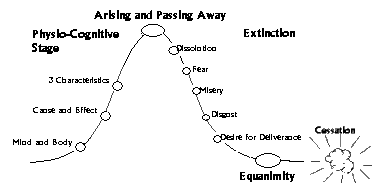 Frankly I’m not absolutely positive this is accurate—but if so—I think this framework is one of the best and most concise explanations of the path there is. This wavelet represents a single sensation, and at each stage, your attention is able to ‘sync up’ further down its lifespan (the macrocosmic following suit).
Frankly I’m not absolutely positive this is accurate—but if so—I think this framework is one of the best and most concise explanations of the path there is. This wavelet represents a single sensation, and at each stage, your attention is able to ‘sync up’ further down its lifespan (the macrocosmic following suit).
-
-
Just read Wikipedia! Topics pertaining to Buddhism are very comprehensively written, with a historical and etymological background and everything. It’s not like it comes with advice though, and it’s not always practical researching terms outside the framework of a certain system; Wikipedia is undestandably more philosophical.
- http://tibetanbuddhistencyclopedia.com is also good, but not as comprehensive.
-
- Naturally, there are some prominent posters with really informative threads. /u/duffstoic or /u/adivader for instance.
-
The Dharma Overground, Daniel Ingram’s forum.
Scientific Links/Resources
-
Qualia Computing | Revealing the computational properties of consciousness
-
https://qualiaresearch.miraheze.org/wiki/Effective_Wellbeing_Engineering
-
Karl Friston & Robin Carhart-Harris. Free energy principle, entropic brain theory, etc.
-
Guru Viking | Trialogue Series - Shinzen, Chelsey, and Jay some of the most important questions are brought up in this series. Though I’ll say most of them aren’t just gone and answered—a few instances “oh my God” though. And then you also get to hear Shinzen Young talk about how profound category theory supposedly is, lol. Apparently that will be important going forward.
-
Orch OR and quantum consciousness
-
https://meditationstuff.wordpress.com/ and https://meditationbook.page/
Studies
-
Neurobiology of Spirituality (3)
- The volitional aspect of non-guided meditation appears to be guided by the Prefrontal Cortex, somewhat moreso on the right, and the Cingulate gyrus.
- (T)he hallmark of altered states of consciousness is the subtle modification of behavioural and cognitive functions that are typically ascribed to the prefrontal cortex… Hyperfunction of the medial PFC, on the other hand, will lead to rigid conformity with rules and customs, excessive concern over oneself and one’s existence and excessive interpretation of the mind of others, all of which results in heightened religiosity (hyperreligiosity). R
- Functional neuroanatomy of altered states of consciousness: The transient hypofrontality hypothesis
- The PFC, when activated via the glutamatergic projections, can activate the Thalamus, especially the reticular nucleus, as part of a more global attentional network. The thalamus mediates the flow to the cortex of sensory information both visual and information needed to determine the body’s spatial orientation via the lateral geniculate body (LGB) and the lateral posterior nucleus (LPN), respectively.
- The visual information is relayed via LGB to the striate (visual) cortex and the spatial information is relayed via LPN to the PSPL (posterior superior parietal lobule). When excited, the reticular nucleus via inhibitory GABAergic projections to the LGB and LPN cuts the input to the striate cortex and the PSPL (especially right). This functional deafferentation means a decrease in the arrival of distracting stimuli to the striate cortex and PSPL, enhancing the sense of focus during meditation.
- The PSPL is involved in the analysis and integration of higher order visual, auditory and somaesthetic information and is also part of the complex attentional network including the PFC and thalamus. The PSPL helps construct a complex three-dimensional image of the body in space, helps distinguish objects and helps identify objects that can be grasped and manipulated. The PSPL deafferentation is supported by three neuroimaging studies, all of which showed decreased activity in the region during intense meditation
- The visual information is relayed via LGB to the striate (visual) cortex and the spatial information is relayed via LPN to the PSPL (posterior superior parietal lobule). When excited, the reticular nucleus via inhibitory GABAergic projections to the LGB and LPN cuts the input to the striate cortex and the PSPL (especially right). This functional deafferentation means a decrease in the arrival of distracting stimuli to the striate cortex and PSPL, enhancing the sense of focus during meditation.
- Evidence of mutual activation of PSNS and SNS, possibly due to the more characteristic PSNS activation causing a ‘breakthrough’/‘discharge’ to the SNS:
- Serotonin, via the mechanism of inhibition of the LGB (lateral genticulate body), greatly reduces the passage of visual information and this results in visual hallucinations.
-
-
-
Neural correlates of religious experience - comparison between religious and non-religious subjects during a psalm recitation thing. Religious subjects did not have activated limbic areas (including Amygdala and Orbitofrontal Cortex), while non-religious subjects did show acivation in left amygdala.
-
Shifting brain asymmetry: the link between meditation and structural lateralization
-
Beyond the veil of duality—topographic reorganization model of meditation (11 Oct 2022) - recent, modern metaanalysis. Seems to have most of the important stuff and in context.
-
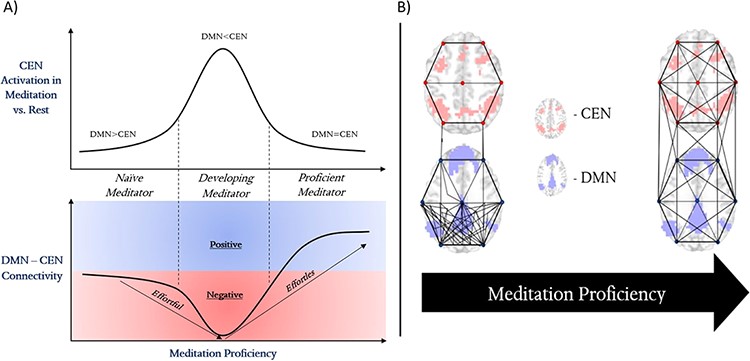 As meditation becomes effortful, that is when the Default Mode Network becomes rewired appropriately and coactivates with the central Executive Network, rather than relying on it.
As meditation becomes effortful, that is when the Default Mode Network becomes rewired appropriately and coactivates with the central Executive Network, rather than relying on it.
-
-
- We advance the hypothesis that the hippocampal sharp wave-ripple (SWR) is a compelling candidate for a brain state that can trigger mind-wandering episodes.
- It propagates activity throughout the Default Mode Network: recollective, associative, imagination and simulation processes
- We advance the hypothesis that the hippocampal sharp wave-ripple (SWR) is a compelling candidate for a brain state that can trigger mind-wandering episodes.
-
Functional Connectivity of Prefrontal Cortex in Various Meditation Techniques – A Mini-Review
The Gray Matter of Grey Matter
There are myriad studies on the effect of various meditation paradigms and the gross anatomical changes they induce in the brain. Some hypertrophy here, some atrophy there. Some activation here, some deactivation there. Honestly I don’t know how relevant the changes in and of themselves are to progress, and who’s to say there’s a universal phenotype, even when you use the same technique?
-
Increased ability to decouple regions in the brain associated with cognitive apprasial of pain: Anterior Cingulate Cortex and Dorsolateral Prefrontal Cortex. And, Ventromedial Prefrontal Cortex for analgesic effects.
-
Experienced meditators had stronger coupling between Posterior Cingulate Cortex, Dorsal Anterior Cingulate Cortex, and Dorsolateral Prefrontal Cortex both when meditating and when not.
-
Frontopolar Prefrontal Cortex: Grey/white matter increase 1
-
Sensory cortex: Grey/white matter increase 1
-
Orbitofrontal Cortex: Grey/white matter increase 1
-
Putamen: Experienced meditations experience slower age-related decline in Grey Matter
-
Insular Cortex: Correlated with thickness, notably right anterior, correlating with accuracy/detection of stimuli. 1, and activation 2
-
Anterior Cingulate Cortex
- Vipassana, et al.: Heightened activity, notably rostral.
- This suggests that meditators have a stronger processing of conflict/distraction and are more engaged in emotional regulation. However, as the meditators become more efficient at focused attention, regulation becomes unnecessary and consequentially decreases activation of ACC in the long term"
- Zen: decreased activity (Ritskes et al., 2003)
- Vipassana, et al.: Heightened activity, notably rostral.
-
Dorsal Anterior Cingulate Cortex: Increased cortical thickness/Grey Matter
-
Posterior Cingulate Cortex
- Samatha/metta/choiceless awareness: Deactivation.
-
Cingulate Cortex: Increased activity during zen
-
Prefrontal Cortex: increased activation increases free synaptic glutamate in the brain. 3
-
Frontal Cortex: Increased activity 2
-
Prefrontal Cortex:
- Vipassana: Increased activity, specifically the dorsal medial prefrontal area, and correlated with thickness.
-
Dorsomedial Prefrontal Cortex
- Increased activation and cortical thickness/Grey Matter.
-
Dorsolateral Prefrontal Cortex: Increased activation of right DLPFC
-
Medial Prefrontal Cortex
- Samatha/metta/choiceless awareness: Deactivation.
-
Occipital Lobe: Metta: enhanced Gamma. Increased activation, notably lateral 2
-
Parietal Lobe: Increase in grey matter and stimulation 2. Vipassana: Significant enhancement of Gamma in experienced meditators.
-
Locus Coeruleus: decreased activation (and its concomitant production of Noradrenaline 3
-
Reticular Nucleus: activation is the chief mechanism responsible for (the) increase in GABA . 3
-
Amygdala: activity reduced, especially in the right hemiphere/right basolateral.
- Reduced right amygdala activity for mindful attenton, but (basically) Metta increased it more than control R
- Impact of short- and long-term mindfulness meditation training on amygdala reactivity to emotional stimuli
- Decreased right amygdala response to pos-neum but heightened connectivity between amygdala and Ventromedial Prefrontal Cortex:
 I reckon the vmPFC activity could be inhibitory projections.
I reckon the vmPFC activity could be inhibitory projections.
- Similarly, there is a negative correlation between Bipolar and Ventral Prefrontal Cortex-amygdala activity.
- Decreased right amygdala response to pos-neum but heightened connectivity between amygdala and Ventromedial Prefrontal Cortex:
-
Brain Stem: Increased grey matter in the Brain Stem. This improves communication between the cortex and all other areas within the brain. R
-
Caudate: strengthened.
-
Medulla: Increased grey matter
-
Precuneus: Increased grey matter
-
Hippocampus: Increase in left grey matter.
-
Corpus Callosum: Grey/white matter increase 1
-
Cerebellum: Activation 2
-
Thalamic nuclei: activation 2
-
Basal Ganglia: activation 2
-
Super longitudinal fasciculus: Grey/white matter increase 1
Cognitive/Psychological
- Experience was found to correlate negatively with reaction times on an Eriksen flanker test.
- Participants with at least 6 years of experience performed better on the Stroop test, and reduced P3 ERP amplitude following the test. Increased amplitude in the N2 ERP. LPP ERP is larger in amplitude.
- Kundalini yoga in 81 participants aged >=55 improved recall/visual memory.
- Mindfulness Training Improves Working Memory Capacity and GRE Performance While Reducing Mind Wandering
- Cognitive regulation: having control over giving attention to a particular stimuli, or by changing the response to it. Achieved through reapprasial (interpreting the stimulus in a more positive manner) and extinction (reversing the response).
- Behavioral regulation: inhibiting the expression of certain behaviors in response to a stimulus.
- Lateral Prefrontal Cortex is important for selective attention, and ventral prefrontal cortex is involved in hibiting response.
- Attentional blink is reduced. P3b ERP amplitude decreased in those who completed a mindfulness retreat.
- Btw, attention residue is when cognitions about a certain task persist even when one has transitioned to another. Clearly then, performance is inhibited. Fuck multitasking.
- Transcendental meditation and improved performance on intelligence-related measures: A longitudinal study
- Twice-daily TM increased CFIT scores by 8 and 9 points over 4 years for university students, and 9 IQ points in high schoolers over only 3.5 months. There are plenty of other studies showing an increase in IQ.
- CFIT has a standard deviation of 24 points. It correlates alright with other IQ tests.
- Twice-daily TM increased CFIT scores by 8 and 9 points over 4 years for university students, and 9 IQ points in high schoolers over only 3.5 months. There are plenty of other studies showing an increase in IQ.
- Fluid intelligence and brain functional organization in aging yoga and meditation practitioners
- Pretty interesting how it takes certain interesting parameters. Yoga > meditation pretty consistently.
- They measured cognitive decline:
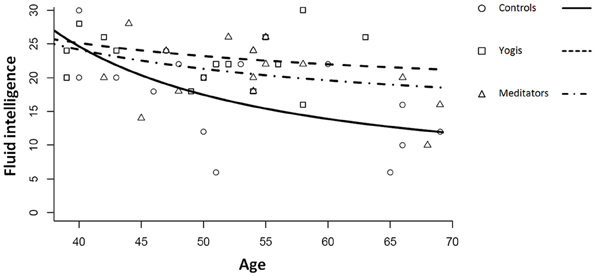
- Fluid intelligence (Raven’s), ‘Brain functional network resilience for targeted damage of 15 nodes’, Global efficiency, and characteristic path length:
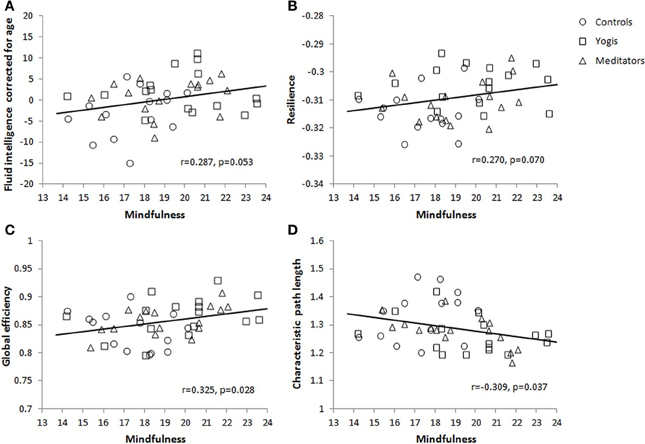
- They measured cognitive decline:
- Pretty interesting how it takes certain interesting parameters. Yoga > meditation pretty consistently.
Neural Oscillations
-
Meditation States and Traits: EEG, ERP, and Neuroimaging Studies (Cahn & Polich 2006)
- Has a mega list of previous studies from 1957-2005.
- Theta and alpha activation related to proficiency of practice.
- Only a few studies, namely Tibetans with metta/dzogchen, or Zen, increased Gamma. Experience probably fills in the gaps for whatever technique they’re using - that is, masters doing normally relaxing may show an increase in Hz if they intend for it to be somehow stimulating.
-
Kundalini/kriya yoga/chakra stuff is implicated with gamma and beta waves.
-
Linked with lower frequency Alpha waves and with Theta waves.
-
Increase in alpha range frequencies, alpha band power, and overall slowing (frequency reduction) in EEG activity, during meditation. For most techniques that is.
-
Beta waves are implicated in thinking, suppressing alpha/gamma.
-
Decreased (even plummetted) frontal, and slight increase in central Delta waves is associated with reduced processing of self-referential thoughts.
-
Nondirective meditation: Significantly increased theta power was found while meditating when averaged across all brain regions, but specifically in frontal and temporal-central regions. Significant increase in alpha power, specifically in the posterior region, which I suppose is complementary to the the theta in the other 2 regions. R
-
Before and after 3-month training. Transcendental meditation. Theta power decreased in left hemisphere, but not right. Increased theta coherence was found overall and in central, temporal, and occipital areas. (There’s more stuff but idk the terminology) R
-
- Subjects: 8 long-term (15-40 years; 10k-50k hours) Tibetan GOATs, and 10 student volunteers who underwent 1 week training @ 1h/day. 30 seconds rest, and 20+60 seconds meditation for 4 times. They did metta!
- Long-term buddhist practitioners induced sustained high-amplitude gamma-band oscillations and phase-synchrony, in particular over lateral frontoparietal electrodes. The students didn’t have shit on the yogis.
- Ratio of gamma-band activity (25-42 Hz) to slow (4-13 Hz) is inititally higher in the resting baseline for practitioners than controls over medial frontoparietal electrodes.
- Very unique in its findings, but considering the subjects, and the meditation technique at that, one can see why. All the Tibetan studies show increases in Gamma, either because dzogchen is epic or whatever, or because the researchers have been finding masters.
-
Is meditation associated with altered brain structure? A systematic review and meta-analysis of morphometric neuroimaging in meditation practitioners (Fox et al., 2014): Meta-analysis of 21 studies on practitioners while not meditating.
- A greater number of structural changes were found in the left hemisphere. This study goes very in-depth into each area, etc. but it isn’t over my head. A very rich article for when I start going beyond the superficial.
- Contains a large summary of (2005-2013) morphometric studies on meditation and their results. There’s some novel info here.
- They make the claim that an increase of structure does often imply an enhancement in function, and that this should be no different. Enthusiasm about altered brain structure in meditation practitioners should therefore be tempered by the fact that the significance of these changes remains controversial; indeed, this is one of the main reasons for the present meta-analysis.
- Kieran C.R. Fox (2016) Functional neuroanatomy of meditation: A review and meta-analysis of 78 functional neuroimaging investigations
- A greater number of structural changes were found in the left hemisphere. This study goes very in-depth into each area, etc. but it isn’t over my head. A very rich article for when I start going beyond the superficial.
-
Neural correlates of attentional expertise in long-term meditation practitioners (Brefczynski-Lewis et al., 2007): MRI during sustained attention ↩︎ ↩︎ ↩︎ ↩︎ ↩︎ ↩︎ ↩︎

